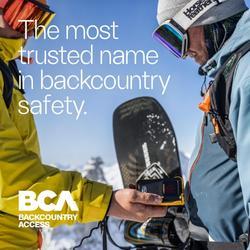Forecast for the Logan Area Mountains

Issued by Toby Weed on
Wednesday morning, February 19, 2025
Wednesday morning, February 19, 2025
There is CONSIDERABLE danger in all upper and mid-elevation terrain, and people are likely to trigger dangerous avalanches of wind drifted storm snow up to 3 feet deep on slopes steeper than 30°. Large natural avalanches are possible, especially on drifted upper-elevation slopes facing northwest through southeast. Heightened avalanche conditions exist on low elevation slopes and loose wet avalanches are possible.
- Careful snowpack evaluation, cautious route-finding, and conservative decision-making are essential for safe backcountry travel today.
- Continue to avoid drifted upper elevation terrain, and stay off and out from under steep drifted slopes.
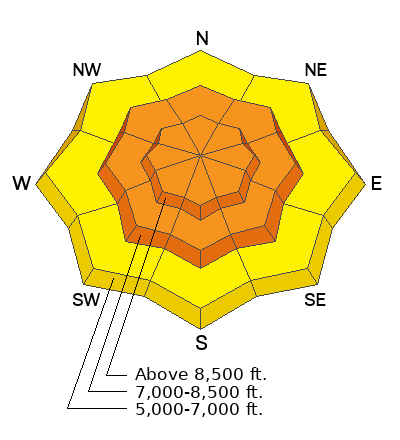
Low
Moderate
Considerable
High
Extreme
Learn how to read the forecast here
 Special Announcements
Special Announcements
Help the University of Utah understand risk behavior in the backcountry by participating in a 15-minute survey. The U will compensate up to $30 for your time! Please note: responses will not be confidential but will be handled ethically under IRB guidelines.
 Weather and Snow
Weather and Snow
The Logan area mountains picked up 3.4 inches of SWE (snow water equivalent) in the past 72 hours, with 6.7 inches of SWE since the morning of 2/13. Strong and sustained winds created deep drifts and wind slabs in upper and mid-elevation terrain. The new snow is so deep it's difficult to move around in, and I immediately sank into waist-deep powder when I hopped off the sled to dig a test pit on the side of the Tony Grove Road at 7500 feet. The avalanche danger remains complex; safe terrain choices are your best bet today, so the best strategy is to stay on slopes less than 30 degrees and out from under steeper terrain. You'll find excellent, DEEP powder riding conditions in the meadows and in low-angle terrain.
Poor visibility has prevented us from viewing upper elevation avalanche terrain, but people reported triggering small slides of storm snow and natural avalanches were observed over the weekend. Most of the recent local avalanches failed on weak layers within the new snow and some on a faceted weak layer capping a dirty crust from early February. There are other persistent weak layers buried in the snowpack, especially in outlying areas with generally shallow snow. With several to choose from, it's difficult to forecast which weak layer will fail when stressed, but given the quantity of new snow, it really doesn't matter because large avalanches will result.
With significantly less recent accumulations, heightened conditions exist in low elevation terrain, where small wind slab and wet avalanches are possible.
-The Tony Grove Snotel at 8400 feet reports a few inches of new snow with .5 inches of SWE in the last 24 hours and 3.4 inches of SWE in the past 72 hours. It's 20° F, with 100 inches of total snow, 117% of normal for the date. The Card Canyon weather station at 8800 feet reports around 1 inch of new snow. It's 16° F, with 69 inches of total snow.
Winds on Logan Peak are blowing 15-25 mph from the west, and it's 13° F. At 9500 feet on Paris Peak it's also 16° F, with winds blowing 13 to 25 mph from the west.
Today will be mostly cloudy with 8500' high temperatures around 24° F, and 7 to 11 mph winds from the west-southwest. Snow is likely in the afternoon, with 1 to 2 inches of accumulation possible. It will snow tonight, with 3 to 7 inches of accumulation possible. Expect temperatures to drop to around 23° F, and 7 to 10 mph winds from the west-southwest. Tomorrow, 1 to 3 inches of snow is expected. High temperatures will be around 27° F and winds from the west-northwest will blow 7 to 13 mph.
It looks like Friday and Saturday will be partly sunny, with the next chance for snow beginning Sunday afternoon.
Thank you for reading our forecasts before heading out into the backcountry - we've had four avalanche fatalities this season and do not want anyone else to die in an avalanche.
For Logan-specific weather, go here: Logan Mountain Weather - Utah Avalanche Center
 Recent Avalanches
Recent Avalanches
Over the weekend, we received many reports of natural and human-triggered small to medium-sized soft slab avalanches. We observed numerous large natural avalanches in the Wellsvilles, which occurred overnight Thursday through early Saturday morning. Some of these were well connected and ran over 2500', hitting Maple Bench above Mendon.
Read about all avalanches and observations in the Logan Zone HERE.
***Remember, the information you share about avalanches you see or trigger in the backcountry could save lives.
Avalanche Problem #1
Wind Drifted Snow
Type
Location
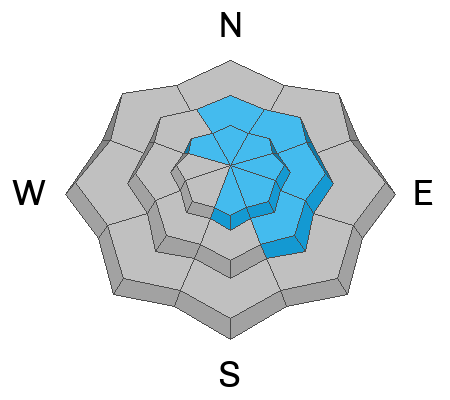
Likelihood
Size
Description
People are likely to trigger dangerous wind slab avalanches, consisting of drifted storm snow, in wind exposed terrain on many upper and mid-elevation slopes. Natural cornice falls and large wind slab avalanches are possible as a tremendous amount of fresh snow has drifted into avalanche starting zones.
- Wind slabs are stiffer than surrounding snow, and they are smooth, rounded and chalky looking, and can sound hollow, like a drum when you move around on them.
- Wind slabs will be found on the lee side of major ridges and corniced slopes facing northwest through southeast, with the majority facing the east half of the compass.
- Drifts and stiff slabs of wind-drifted snow also exist on all aspects in and around terrain features like sub-ridges, gullies, scoops, and cliff bands.
- Cracking and whumpfs are sure signs of instability.
Avalanche Problem #2
New Snow
Type
Location
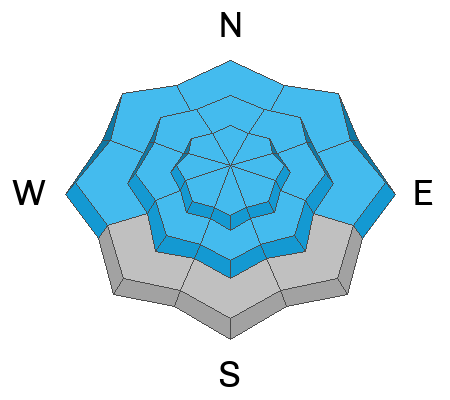
Likelihood
Size
Description
Soft slab and loose avalanches of storm snow are likely on steep slopes in upper and mid-elevation terrain. People are likely to trigger avalanches on slopes steeper than about 30°, and avalanches could be triggered remotely (from a distance) or from below steep slopes. Copious amounts of new snow blanket the range and, having accumulated on top of multiple weak layers, it's hard to know which slopes are the most tenuous. Recent sizable avalanches failed on weak layers within the new snow, and yesterday, we found reactive weak layers within the new snow in test pits.
Wet avalanches are possible in lower-elevation terrain in the heat of the day, like on the steep slopes above the Logan River.
Avalanche Problem #3
Persistent Weak Layer
Type
Location
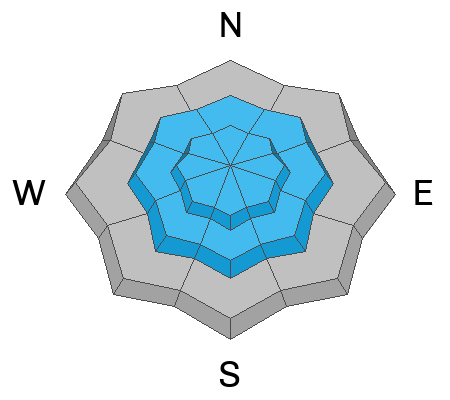
Likelihood
Size
Description
Large and dangerous avalanches stepping down into older snow on one of several buried persistent weak layers are possible, especially in areas with shallower snow and poor snow structure. While we have not seen much recent activity on a PWL, sugary weak layers exist on slopes facing every direction, not just the northern half of the compass like we saw earlier in the season. One suspect layer is found right on top of a dirty melt-freeze crust from the warm spell at the beginning of February, others consist of crust-facet sandwiches. We've also been monitoring more deeply buried PWLs near the ground, which may produce large avalanches, especially in outlying terrain with shallow and generally weak snow.
- Audible collapses (whumpfs) and shooting cracks are sure signs of instability, but these may not be present when avalanches occur.
- Avalanches failing on a buried persistent weak layer might be triggered remotely (from a distance) or from below steep slopes.
Additional Information
On Saturday, I could see evidence of numerous natural avalanches in the Wellsville Range. This one in North Shumway is on an east-southeast facing slope.
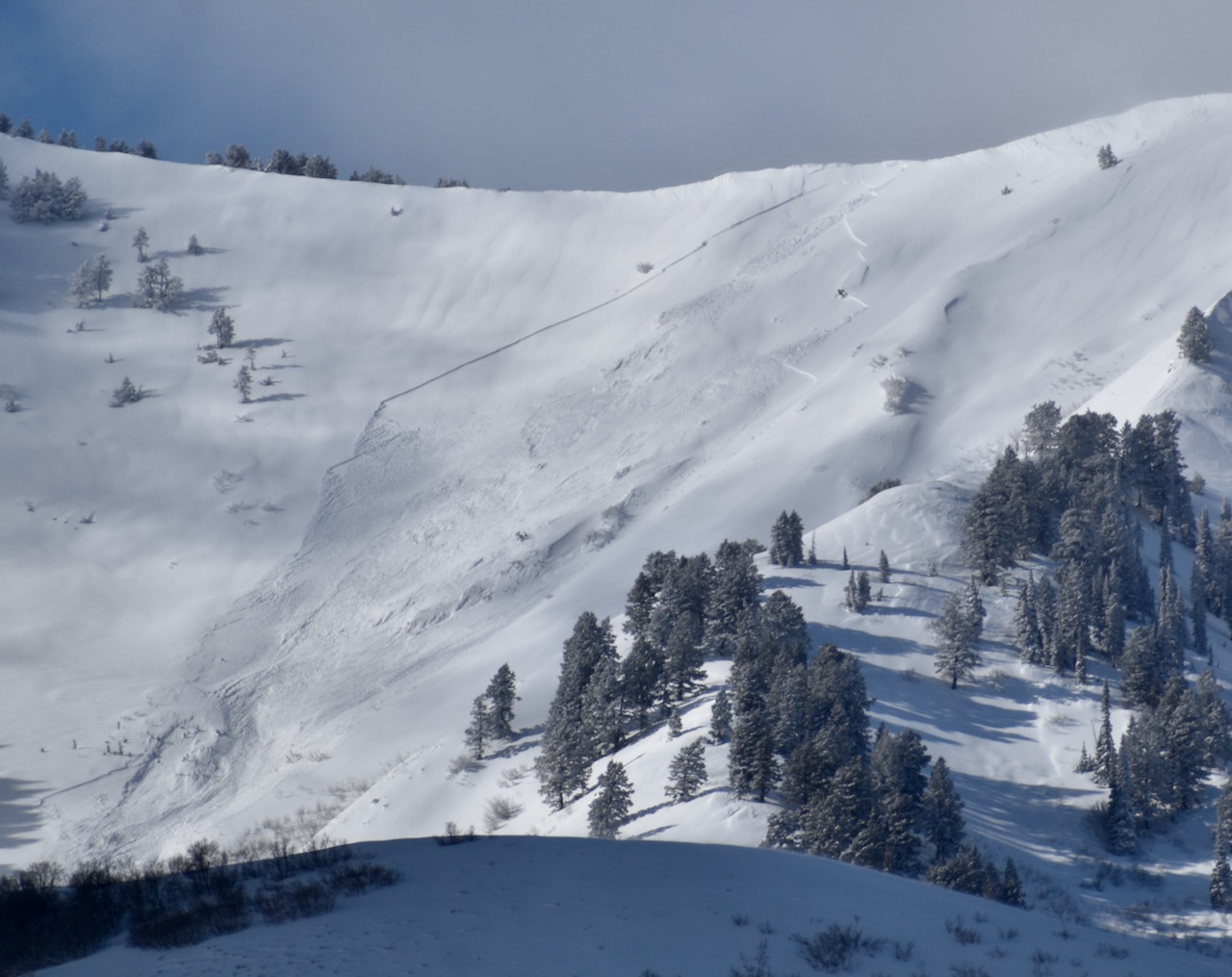
General Announcements
-National Forest Winter Recreation Travel Maps show where it's open to ride: UWCNF Logan, Ogden LRD Tony Grove, Franklin Basin CTNF Montpelier
-For all questions on forecasts, education, Know Before You Go, events, online purchases, or fundraising, call 801-365-5522.
-Remember the information you provide could save lives, especially if you see or trigger an avalanche. To report an avalanche or submit an observation from the backcountry, go HERE.
-Receive forecast region-specific text message alerts to receive messages about changing avalanche conditions, watches, and warnings. Sign up and update your preferences HERE.
This forecast is from the U.S.D.A. Forest Service, which is solely responsible for its content. This forecast describes general avalanche conditions, and local variations always occur.




